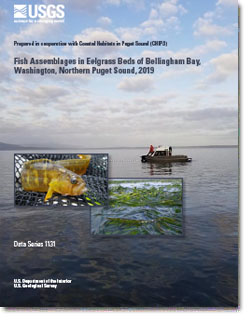Data Series 405

AbstractThis report presents the study design and environmental data for an integrated chemical and biological study of three streams (South Fork Crow River, Redwood River, and Grindstone River) that receive wastewater in Minnesota. The objective of the study was to identify distribution patterns of endocrine-active chemicals and other organic chemicals indicative of wastewater, and to identify fish responses in the same streams. Endocrine-active chemicals are a class of chemicals that interfere with the natural regulation of endocrine systems, and an understanding of their distribution in aquatic systems is important so that aquatic organism exposure can be evaluated. This study was a cooperative effort of the U.S. Geological Survey (USGS), the Minnesota Pollution Control Agency, and St. Cloud State University (St. Cloud, Minn.). The USGS collected and analyzed water and quality-assurance samples and measured streamflow during six sampling events in each of three streams. Water samples were collected upstream from and at two successive points downstream from wastewater-treatment plant (WWTP) effluent discharge and from treated effluent from February through September 2007. Bed-sediment samples were collected during one sampling period at each of the stream locations. Water and bed-sediment samples were analyzed for endocrine-active chemicals including alkylphenols, alkylphenol polyethoxylates, and nonylphenol ethoxycarboxlylates (NPECs). Water samples also were analyzed for major ions, nutrients, and organic carbon. In addition, as part of an intensive time-series investigation, the USGS staff collected daily water samples for 8 weeks from the Redwood River near Marshall, Minn., for analyses of total alkylphenols and atrazine. St. Cloud State University staff collected and analyzed fish to determine male fish responses at all water sampling sites and at an additional site near the discharge of wastewater-treatment plant effluent to these streams. Male fish responses included the presence and concentration of vitellogenin in plasma, gonadosomatic indices, and histological characterizations of liver and testes tissue. Hydrologic, chemical and biological characteristics were different among sites. The percentage of streamflow contributed by WWTP effluent (ranging from less than 1 to 79 percent) was greatest at the South Fork Crow River and least at the Grindstone River. WWTP effluent generally contributed the greatest percentage of streamflow during winter and late summer when streamflows were low. A wide variety of chemicals were detected. More chemicals were detected in WWTP effluent samples than in stream samples during most time periods. The most commonly detected chemicals in samples collected monthly and analyzed at the USGS National Research Program Laboratory were 2,6-di-tert-butyl-1,4-benzoquinone, 2,6-di-tert-butyl-4-methylphenol, 3-beta-coprostanol, 4-methylphenol, 4-nonylphenol (NP), 4-tert-octylphenol, bisphenol A, cholesterol, ethylenediaminetetraacetic acid, and triclosan. The chemicals 4-nonylphenolmonoethoxycarboxylate (NP1EC), 4-nonylphenoldiethoxycarboxylate (NP2EC), and 4-nonylphenoltriethoxycarboxylate (NP3EC) also were detected. Excluding nondetections, the sum of NP1EC through NP3EC concentrations ranged from 5.1 to 260 µg/L among all samples. NP was detected in upstream, effluent, and downstream samples in each stream during at least one time period. NP was detected in 49 percent of environmental samples. Excluding nondetections, concentrations of NP ranged from 100 to 880 nanograms per liter among all samples. NP was also detected in more than one-half of the bed-sediment samples. The most commonly detected wastewater indicator chemicals in samples analyzed by schedule 4433 at the USGS National Water Quality Laboratory were 3,4-dichlorophenyl isocyanate, acetyl-hexamethyl-tetrahydronaphthalene, benzophenone, cholesterol, hexahydrohexamethyl-cyclopenta-benzopyran, N,N-diethyl-meta-toluamide, and tri(dichloroisopropyl) phosphate. Male fish responses were the focus of the fish analyses, and 508 male fish were collected among all sampling sites. Vitellogenin was detected in 57 percent of the 415 male fish analyzed; concentrations ranged from an estimated value of 0.1 to 330 micrograms per milliliter (µg/mL) (average of 17.1 µg/mL). Intersex (the presence of oocytes in testes tissue) was observed in only one fathead minnow from an upstream site on the Grindstone River. |
Posted January 8, 2009
For additional information contact: Part or all of this report is presented in Portable Document Format (PDF); the latest version of Adobe Reader or similar software is required to view it. Download the latest version of Adobe Reader, free of charge. |
Lee, K.E., Schoenfuss, H.L., Jahns, N.D., Brown, G.K., and Barber, L.B., 2008, Alkylphenols, other endocrine-active chemicals, and fish responses in three streams in Minnesota—Study design and data, February–September 2007: U.S. Geological Survey Data Series 405, 44 p. plus appendixes.
Abstract
Introduction
Study Design and Approach
Collection and Analysis Methods
Quality Assurance and Control
Data Description
Summary
References Cited
Appendixes